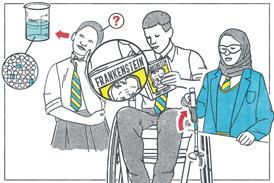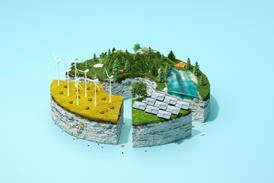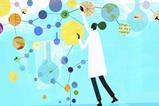Learn how you can use augmented reality to help students visualise organic mechanisms and reduce cognitive load

Experts in chemistry can navigate effortlessly through all three levels of Johnstone’s triangle: macroscopic, submicroscopic, symbolic. However, this is often a challenge for students.
Students require support to relate what they see and experience when carrying out a chemical reaction to the interactions and changes happening on the molecular scale. Part of the problem in navigating Johnstone’s triangle relates to cognitive load.
Cognitive load theory considers memory to be either long-term, where information is stored, or working memory, where information is processed. Working memory is said to be limited in capacity while long-term memory is essentially unlimited.
When related to how students use their working memory, especially when carrying out different learning tasks, cognitive load can be either intrinsic, extraneous or germane.
A good learning task minimises the extraneous and maximises the germane cognitive load
Intrinsic cognitive load is related to the inherent difficulty of processing a particular piece of information. Extraneous cognitive load refers to extra, unwanted demand based on how information is presented. Germane cognitive load is the effort needed to process information into long-term storage. A good learning task minimises the extraneous and maximises the germane cognitive load.
Teaching tips
- In this study, researchers developed a new AR learning environment (AR-LE) to teach electrophilic aromatic substitutions. You can access their resource to try it out – you just need to download an AR app for your device. Note, the resource is in German.
- The AR-LE used all three representational levels of Johnstone’s triangle but you can also interact with them separately.
- The same researchers have other AR resources on their website that you can investigate with your classes.
- Beyond the specific resource developed, the study raises thoughts about technology use in general. For example, when introducing new technologies, it is important to think about how these might affect a student’s cognitive load. Use the surveys in this study to investigate cognitive load in your own setting.
Teaching tools that can help students master the different levels of representation in Johnstone’s triangle, while simultaneously not negatively affecting their cognitive load, would be useful. Augmented reality (AR) could be such a tool.
Although there have been several studies into how AR can be used in teaching chemistry, not many have delved into the teaching of organic chemistry mechanisms while considering multiple representations.
Using AR for cognitive load
Researchers from Germany have developed an AR learning environment (AR-LE) for teaching electrophilic aromatic substitution mechanisms. With this AR-LE, students experience a video of the experiment (macroscopic level), a 2D-AR animation of the mechanism using Lewis structures (symbolic level), and a 3D-AR animation of the mechanism with molecular structures (submicroscopic level).
There were 44 high school students from five different classes that experienced the AR-LE. To test its effectiveness, researchers tested the learners’ knowledge of related mechanisms before and after the lesson. They also answered questions about the cognitive load they experienced and their attitude towards the use of the AR-LE to learn chemistry.
The results showed that students experienced a learning gain associated with the mechanism of the electrophilic aromatic substitution of bromine onto benzene after completing the AR-LE lesson. The students also viewed the AR-LE as easy to use and reported a positive attitude toward their learning experience.
Importantly, students reported that they experienced low extraneous cognitive load and high germane cognitive load when using the AR-LE. This is a good result for any learning experience.
Reference
M Bullock et al, J. Chem. Educ., 2024, 101, 4, 1534–1543 (doi.org/10.1021/acs.jchemed.3c00903)
Fraser Scott
References
M Bullock et al, J. Chem. Educ., 2024, 101, 4, 1534–1543 (doi.org/10.1021/acs.jchemed.3c00903)











3 readers' comments